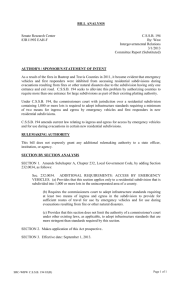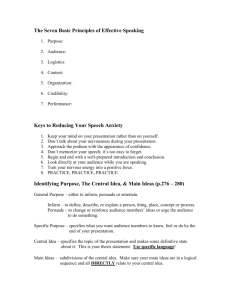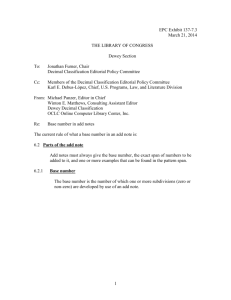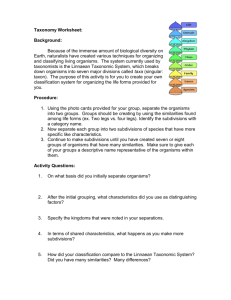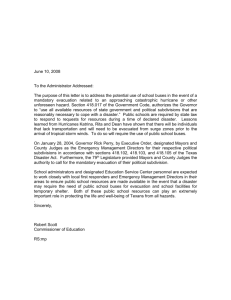Numerical Integration, One Step at a Time
advertisement
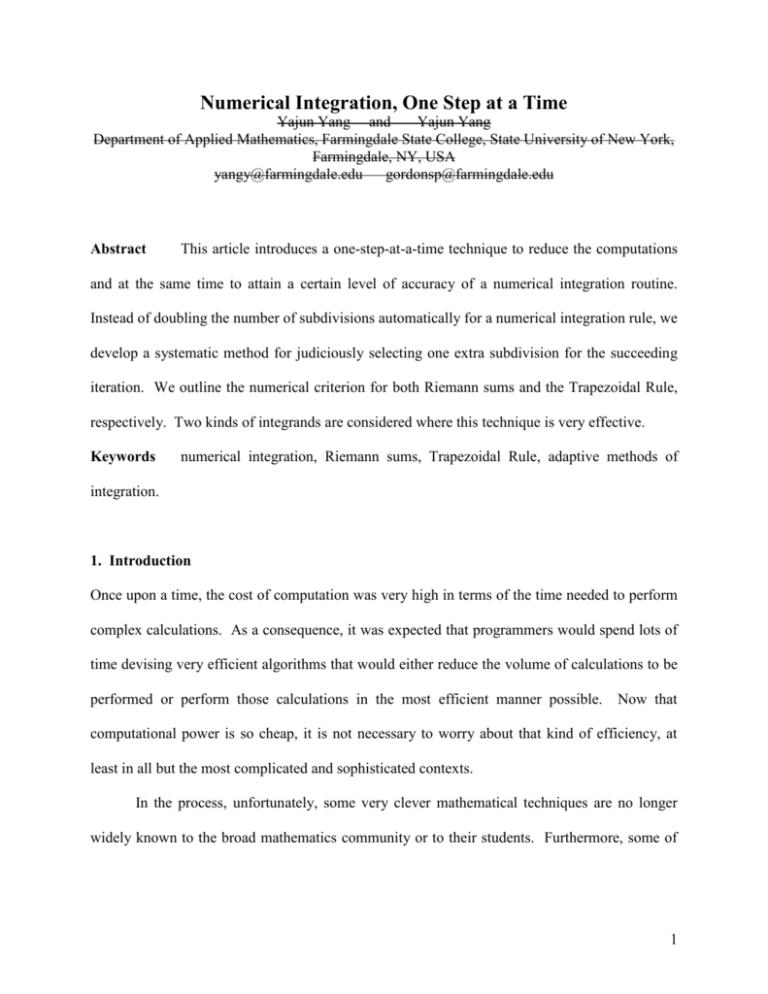
Numerical Integration, One Step at a Time Yajun Yang and Yajun Yang Department of Applied Mathematics, Farmingdale State College, State University of New York, Farmingdale, NY, USA yangy@farmingdale.edu gordonsp@farmingdale.edu Abstract This article introduces a one-step-at-a-time technique to reduce the computations and at the same time to attain a certain level of accuracy of a numerical integration routine. Instead of doubling the number of subdivisions automatically for a numerical integration rule, we develop a systematic method for judiciously selecting one extra subdivision for the succeeding iteration. We outline the numerical criterion for both Riemann sums and the Trapezoidal Rule, respectively. Two kinds of integrands are considered where this technique is very effective. Keywords numerical integration, Riemann sums, Trapezoidal Rule, adaptive methods of integration. 1. Introduction Once upon a time, the cost of computation was very high in terms of the time needed to perform complex calculations. As a consequence, it was expected that programmers would spend lots of time devising very efficient algorithms that would either reduce the volume of calculations to be performed or perform those calculations in the most efficient manner possible. Now that computational power is so cheap, it is not necessary to worry about that kind of efficiency, at least in all but the most complicated and sophisticated contexts. In the process, unfortunately, some very clever mathematical techniques are no longer widely known to the broad mathematics community or to their students. Furthermore, some of 1 those clever techniques can be very accessible and useful to the students in terms of expanding their own understanding of the mathematics and developing their own conceptual skills. For instance, consider the notion of numerical integration. A common rule of thumb is to continue doubling the number of subdivisions until there is no further change in some of the digits of the answer; those digits are then correct. The blithe assumption that one can keep doubling the number of subdivisions, however, presupposes that the “cost” of computation is negligible. What if it isn’t? One technique that could be used to save on computational time is to realize that in the process of doubling the number of subdivisions, say with Riemann sums or the trapezoidal rule, one is re-calculating all the function values at the previous points while obtaining the values at each of the “new” intermediate points. So, a major saving in computation time can be achieved by retaining the previous values and only performing the necessary calculations at each new point of the subdivision. But, let’s take this issue of trying to reduce the computations needed to attain a certain level of accuracy to an extreme. Suppose we wish to approximate the definite integral of f ( x) e x on the interval [0,1] . We know that this integral has the value e 1 1.71828183 , correct to eight decimal places, which we will use throughout the article as a target. Suppose we begin with Riemann sums with n 4 uniformly spaced subdivisions, so that x 0.25 and we have the function evaluated at x = 0, 0.25, 0.5, 0.75 and perhaps at 1. With left-hand sums, the approximate value for the definite integral is 1.51243668 and with right-hand sums, it is 1.94200713. We show the graph of the left-hand sums in Figure 1. The corresponding errors in the left-hand and the right-hand estimates are 1.71828183 1.51243668 = 0.20584515 and 1.71828183 1.94200713 = 0.22372530, respectively. 2 3 2.5 2 1.5 1 0.5 0 0 0.25 0.5 0.75 1 Figure 1: Left-hand Riemann Sum with n = 4 Uniform Subdivisions 2. Improving on Riemann Sums Suppose now that we increase the number of subdivisions by just one to consider n 5 . If we proceeded without thinking and use 5 uniformly spaced subdivisions with x 0.2 , this would entail calculating an almost completely new set of function values at x = 0.2, 0.4, 0.6, and 0.8 in addition to the endpoints x = 0 and x = 1. The associated left-hand sums would then be 1.55217744, which is certainly closer to the correct answer of 1.71828183 than the 1.51243668 we had with n 4 subdivisions. The associated error in the estimate using this Riemann sum is then 1.71828183 1.55217744 = 0.16610439, which is considerably smaller than the value we had above for n 4 . Similarly, the comparable right-hand Riemann sum is 1.89583380 and the associated error is 0.17755197. Again, this is considerably better than the result with n 4 subdivisions. Before continuing in this manner, however, consider the graph in Figure 1. It is evident that the greatest error, by far, occurs in the last of the four subdivisions. What if we kept the first three subdivisions unchanged and split the last subdivision into two? We would then have the points x = 0, 0.25, 0.50, 0.75, and 0.875. The corresponding values for ∆x would be 0.25 for the 3 first three subdivisions and 0.125 for the last two. The resulting approximation to the definite integral is 1.54767109, as shown in Figure 2. This approximation is almost as accurate as the one, 1.55217744, we obtained previously with n 5 uniformly spaced subdivisions, but with considerably less computation. The associated error with this left-hand sum estimate is 1.71828183 1.54767109 = 0.17061074, which is slightly larger than the value we obtained above with n 5 uniformly spaced subdivisions. In a similar way, we find that the corresponding right-hand sum approximation to the definite integral is 1.90208132 and the resulting error is 0.18379949. Again, this is almost as accurate as the result with n 5 uniformly spaced subdivisions. Suppose we continue this approach using n 6 subdivisions. From Figure 2, it is evident that the greatest discrepancy between the area under the curve for the function and an approximating rectangle is now in the third subdivision from x = 0.5 to x = 0.75, so we split the interval in half at x = 0.625. We show this in Figure 3. The resulting value for the left-hand Riemann sum is 1.57511167 with an associated error for the estimate of 1.71828183 1.57511167 = 0.14317014. The comparable value for the right-hand Riemann sum is 1.87098076 with an associated error of 0.15270523. Either way, we achieved a reasonably decent improvement in the estimates. 3 3 2.5 2.5 2 2 1.5 1.5 1 1 0.5 0.5 0 0 0 0.25 0.5 0.75 Figure 2: Left-hand Riemann Sum with n = 5 non-uniform subdivisions 1 0 0.25 0.5 0.75 1 Figure 3: Left-hand Riemann Sum with n = 6 non-uniform subdivisions 4 In order to make this approach into a usable technique, we need a systematic method for determining which subdivision to choose to split into two for the succeeding iteration. One simple visual criterion that can be used, say for the left-hand Riemann sum approximations, at least when the function f is monotonic and of fixed concavity, is to make the decision based on which of the “triangles” above the rectangular strips has the largest area, since the area of each “triangle” is approximately equal to the area of the region under each portion of the curve and above (or below for a decreasing function) the approximating strip. A numerical criterion that achieves the equivalent effect is first to calculate the product of the difference in the vertical heights f ( xi 1 ) f ( xi ) and the horizontal distance between each pair of successive points of the subdivisions on the graph of the function f ( x) e x . This product, in fact, gives twice the area of the “triangle”. Second, then subdivide the interval corresponding to the largest value of the product. Effectively, then, we are adding additional rectangles where they will do the most good in terms of reducing the error in the approximation. This procedure can certainly be done visually, at least when there are a small number of subdivisions. It can also be done automatically – the calculation of areas of triangles using the various values for ∆x for the base and the previously calculated function values for the height is certainly faster in terms of machine time than calculating many new values of a function. This procedure will improve the estimates of the numerical integration routine used significantly, if (1) the function is continuously differentiable, but increases or decreases dramatically over the interval, or (2) the function is only continuous on the interval but has infinite slope at a point. For the first case where a function is continuously differentiable on the interval, let’s consider g ( x) x15 on [0,1] . Comparing this to f ( x) e x whose derivative on [0,1] varies between e0 1 and e1 2.71828183 , we see that the values of the rate of change of the function 5 g ( x ) have a much greater spread because 0 g ( x) 15 for x [0,1] . Now let’s use left-hand Riemann sums to approximate the definite integral of g ( x ) on the interval [0,1] . With n 4 uniformly spaced subdivisions, the approximate value for the definite integral is 0.00334849 and the corresponding error is 0.05915151. If we follow the usual guideline in calculus texts to double the number of subdivisions, then the resulting approximation for the left-hand Riemann sums with n 8 is 0.01864945 and the corresponding error is 0.04385055. However, let’s see what happens if we take just one extra subdivision instead of doubling the number of subintervals. When we use n 4 uniformly spaced subdivisions, by inspection of the graph of g ( x ) shown in Figure 4, it is apparent that the greatest error for the left-hand Riemann sum will occur in the last of the four subdivisions. Now we follow the above algorithm, we have the points x = 0, 0.25, 0.50, 0.75, 0.875 and 1 for the next round of subdivisions, as shown in Figure 5. The resulting left-hand Riemann sum is 0.01854479 and the corresponding error is 0.04395521, which is very close to the error for n 8 uniformly spaced subdivisions. Thus, by choosing one extra subdivision judiciously, we have achieved a reasonably good result. 1.2 1.2 1 1 0.8 0.8 0.6 0.4 g ( x) x15 0.6 g ( x) x15 0.4 0.2 0.2 0 0 0 0.25 0.5 0.75 1 Figure 4: Left-hand Riemann Sum with n = 4 Uniform Subdivisions for g ( x) x15 0 0.25 0.5 0.75 1 Figure 5: Left-hand Riemann Sum with n = 5 Non-Uniform Subdivisions for g ( x) x15 6 If we apply the above approximation process to a power function having a higher power, say g ( x) x 45 , then the error with n 8 uniformly spaced subdivisions is 0.02143174; this level of accuracy (correct to eight decimal places) can also be achieved by using the non-uniform subdivisions by adding one point x = 0.875 to the n 4 uniformly spaced subdivisions. Essentially, in going from n 4 to n 8 subdivisions, the improvements from the first three subintervals is so insignificant, compared to the gain from the last subinterval, that all the gain achieved happens by splitting the fourth subinterval. These calculations of the errors indicate that the bigger the variation in the derivative of a function, the greater the benefit from adding a judiciously chosen point to the subdivisions. Now let’s look at the case where the function is only continuous on the interval, but has infinite slope at a point. We consider the function h( x) x on [0,1] , which is continuous on [0,1] and differentiable everywhere except at x 0 . Table 1 gives the summary of the errors of left-hand Riemann sums for uniform subdivisions with n 4 (shown in Figure 6), with n 5 , and with n 8 . It also shows the errors associated with non-uniform subdivisions with appropriately chosen additional suitably chosen points for n 5 and n 6 ; the corresponding images are shown in Figures 7 and 8. The approximation based on n 5 non-uniform 1.2 Table 1 Errors of left-hand sums for h( x) x Division Error n = 4 uniform 0.14838362 n = 5 uniform 0.11692807 n = 5 (x = 0.125) 0.10418945 n = 6 (x = 0.125, 0.375) 0.09014289 n = 8 uniform 0.07103645 1 h( x ) x 0.8 0.6 0.4 0.2 0 0 0.25 0.5 0.75 1 Figure 6: Left-hand Riemann Sum with n = 4 Uniform Subdivisions for h( x) x 7 1.2 1.2 1 1 h( x ) x 0.8 h( x ) x 0.8 0.6 0.6 0.4 0.4 0.2 0.2 0 0 0 0.25 0.5 0.75 0 1 0.25 0.5 0.75 1 Figure 8: Left-hand Riemann Sum with n = 6 Non-Uniform Subdivisions for h( x) x Figure 7: Left-hand Riemann Sum with n = 5 Non-Uniform Subdivisions for h( x) x subdivisions is an improvement compared to the case with n 5 uniform subdivisions. And the n 6 non-uniform subdivisions produce an approximation that is getting closer in magnitude to the one based on n 8 uniform subdivisions. If we change the function h( x) x to k ( x) 5 x , the results, shown in Table 2, reveal that the error with n 5 non-uniform subdivisions is about two-thirds of the error with n 5 uniform subdivisions. And this time, n 6 non-uniform subdivisions, shown in Figure 9, produce a much better approximation when compared to the one with n 8 uniform 1.2 Table 2 Errors of left-hand sums for k ( x) x Subdivisions Error n = 4 uniform 0.19020924 n = 5 uniform 0.15002017 n = 5 (x = 0.125) 0.10774000 n = 6 (x = 0.125, 0.0625) 0.07184318 n = 8 uniform 0.09107639 5 k ( x) 5 x 1 0.8 0.6 0.4 0.2 0 0 0.25 0.5 0.75 1 Figure 9: Left-hand Riemann Sum with n = 6 Non-Uniform Subdivisions for k ( x) 5 x 8 subdivisions. As the previous two examples show, the bigger the index of the radical, the greater the benefit from adding a judiciously chosen point to the subdivisions. 3. Improving on the Trapezoidal Rule We next consider how these ideas extend to a comparable one-step-at-a-time improvement using the Trapezoidal Rule. We again consider the case of f ( x) e x on the interval [0,1] , where the function is increasing and concave up. As before, we start with n 4 subdivisions, as shown in Figure 10. The approximate value produced by the Trapezoidal Rule is then 1.72722191 compared to the actual area, which is 1.71828183, and so the corresponding error is 0.00894007. This clearly is significantly smaller than the errors we cited above based on Riemann Sums. If we follow the usual guideline in calculus texts to double the number of subdivisions, then the resulting approximation with n 8 trapezoids is 1.72051859 and the corresponding error is 0.00223676. Thus, we have reduced the size of the error by roughly a factor of 4, which is a very substantial improvement. And the improvement in the error achieved by doubling the number of subdivisions is a reduction of 0.00894007 0.00223676 = 0.00670331. The Trapezoidal Rule 3 2.5 2 1.5 1 0.5 0 0 0.25 0.5 0.75 1 Figure 10: Trapezoidal Rule with n = 4 9 However, let’s see what happens if we take just one extra subdivision instead of doubling the number. First, for comparison purposes, suppose that we take n 5 uniformly spaced subdivisions. The resulting Trapezoidal Rule approximation is then 1.72400562 and the corresponding error is then 0.00572379. See Figure 11. Consequently, in going from n 4 to n 5 uniformly spaced subdivisions, the error has been reduced by 0.00894007 0.00572379 = 0.00321628, which is roughly half the improvement achieved by doubling the number of subdivisions. The Trapezoidal Rule 3 2.5 2 1.5 1 0.5 0 0 0.2 0.4 0.6 0.8 1 Figure 11: Trapezoidal Rule with n = 5 Alternatively, let’s see what happens if we take n 5 subdivisions, but do so by selecting the extra subdivision judiciously. If you inspect Figure 10 carefully (perhaps by using a graphing calculator so that you can zoom in on each portion of the graph), you may observe that the largest error occurs in the last subdivision, which corresponds to x between 0.75 and 1. Equivalently, the curve deviates most from one of the linear approximations across that subdivision in which the curve bends most sharply – that is, where the curvature, and hence the second derivative, is the greatest in magnitude. This happens across the last subdivision for the exponential growth function f ( x) e x . We therefore add the point x = 0.875 to our subdivisions, 10 as shown in Figure 12. The resulting value for the sum of the areas of the n 5 trapezoids is 1.72487620, and so the corresponding error is 0.00659437. This is slightly less of an improvement (a reduction of 0.00894007 0.00659437 = 0.00234570) compared to what was obtained (0.00321628) by using n 5 uniformly spaced subdivisions. Essentially, we reduced the error in only one of the original four subdivisions; the errors in the remaining trapezoids were unaffected. In comparison, when we used five uniformly spaced subdivisions, we reduced the errors in all four of the original subdivisions. However, the improvement with the intelligently selected extra subdivision was accomplished by having to perform only one extra function evaluation, so one might consider it as being more “cost-effective”. We suggest that the interested readers (or their students) might investigate what happens in going from n 5 to n 6 subdivisions, both with a uniform approach and with a judiciously selected extra subdivision. The Trapezoidal Rule 3 2 1 0 0 0.125 0.25 0.375 0.5 0.625 0.75 0.875 1 Figure 12: Trapezoidal Rule with n = 5 Non-Uniform Subdivisions Because the Trapezoidal Rule typically produces more accurate approximations to a definite integral than Riemann Sums do, it often becomes hard to see from graphs of functions which interval in the subdivision should be selected for a refinement. We know that the curve 11 will deviate most from one of the linear approximations across a subdivision in which the curve bends most sharply. A simple way to measure this deviation on an interval is to find the vertical distance at the midpoint of the interval between the secant line and the curve. We then can make the decision based on which of the subintervals has the largest vertical distance, when the subdivisions are uniform. Otherwise, we will choose the subinterval based on the largest product of this vertical distance at the midpoint and the width of the subinterval. To illustrate this numerical criterion for selecting such an interval, let’s examine how the error of the Trapezoidal Rule is reduced when we divide an interval into two equal subintervals. Consider the increasing, concave up function F ( x) on the interval [a, b] shown in Figure 13. Figure 13 also shows the graph of the Trapezoidal Rule applied to the function F ( x) on [a, b] . When we split the interval [a, b] into two subintervals [a, a2b ] and [ a2b , b] , then the reduction of the errors of Trapezoidal Rule is the area of the shaded region in Figure 14. Let the area for the left shaded region be A1 and the right portion be A2, respectively. To calculate A1 and A2, notice that h is the base and ba is the height for both triangles by rotating the graph in Figure 13 by 2 90 degrees. So the total area of this shaded region is 1 ba 1 ba ba )h ( )h h, A1 + A2 ( 2 2 2 2 2 where h is the distance between the secant line and the graph of the function at the midpoint of the interval [a, b] . It can be calculated by the following formula h F (a ) F (b) ab F( ). 2 2 When the subdivisions are uniform, then the areas vary with the vertical distances h. It suffices to make the selection of the subinterval based on the largest vertical distance. 12 A2 A1 F ( x) 0 0 0 a b Figure 13: Trapezoidal Rule 0 a h F ( x) a b 2 b Figure 14: Trapezoidal Rule with n = 2 With this numerical criterion, let’s consider g ( x) x15 on [0,1] using the Trapezoidal Rule. Table 3 gives results of the errors with n 4 , with n 5 , and with n 8 uniform subdivisions. It also includes the errors associated with non-uniform subdivisions with additional points selected by the numerical criterion for n 5 and n 6 . The approximation based on n 5 non-uniform subdivisions is a great improvement compared to the case with n 5 uniform subdivisions, that is, the error with n 5 non-uniform subdivisions is more than half of the error with n 5 uniform subdivisions. And n 6 non-uniform subdivisions produce a much better approximation when compared to the one with n 8 uniform subdivisions. Table 3 Errors of Trapezoidal Rule for g ( x) x15 Division | Error | n = 4 uniform 0.06584849 n = 5 uniform 0.04463113 n = 5 (x = 0.125) 0.01938001 n = 6 (x = 0.125, 0.0625) 0.00765160 n = 8 uniform 0.01864945 13 We suggest that the interested readers (or their students) might investigate the numerical integration results with one-step-at-a-time improvement using the Trapezoidal Rule when the numerical criterion is applied to the functions h( x) x and k ( x) 5 x . 4. Conclusion The ideas discussed here can be extended to apply to comparable improvements in more sophisticated numerical integration methods such as Simpson's Rule. However, things become somewhat more complicated because there are not such simple computational criteria for selecting which particular subinterval is to be split into two. The one-step-at-a-time strategy is a simple way to introduce what are known as adaptive methods of integration, in which the integration rule selects the placement of points for subdivisions according to the behavior of the integrand. Many integrands vary in their smoothness or differentiability at different points of the interval of integration [a, b] , or in the magnitude of their derivatives on [a, b] if they are differentiable. When the integrand is badly behaved at some point in the interval [a, b] , adaptive integration attempts to place more subdivisions near the point to compensate for the bad behavior, resulting in smaller subdivisions (or a denser set of subdivisions) near the point and fewer and therefore a sparser set of subdivisions away from α (see [1, 2, and 3]). The examples we investigated, such as g ( x) x15 and h( x) x , can be used to explain the basic concept of adaptive integration. Moreover, the empirical investigation in general is the first step to improve the performance of the numerical integration. 14 References [1] R. L. Burden and J. D. Faires, Numerical Analysis 9th Ed., Brooks/Cole (2010). [2] T. H. Fay, and R. A. Guidry, “Teaching Numerical Integration in a Revitalized Calculus II”, Mathematics and Computer Education, Vol. 26, pp. 278-291 (1992). [3] K. E. Atkinson, An Introduction to Numerical Analysis 2nd Ed., Wiley, (1989). 15


